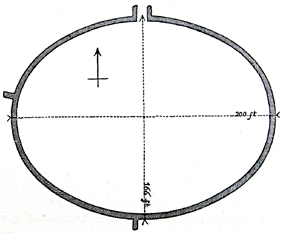|
Victoria
County History of Kent Vol. 3
1932 Romano-British
Kent - Military History Page 33
|
broken pottery, some burnt wheat and burnt
cordage (?), and various small objects, in particular a little
votive ‘thumb’ in bronze.36 Dowker inferred
from the burnt wheat the existence of large granaries. But
nothing in the recorded remains really resembles the granaries
on other Roman sites. We may think rather of poor cottages, the
homes and shops of fishers and harbourmen. It must be confessed
that the evidences accord little with our ideas of a flourishing
town and port.
To the south of the fortress four sites have
produced structural relics of importance. On the highest part of
the hill, 450 yards from the fortress, are the buried remains of
a small amphitheatre.37 This has been known and
recognized since Leland, who says that in his time it was called
Littleborough. Roach Smith partially excavated it in 1849. It
proved to be elliptical in shape, measuring 166 ft. by 200 ft.,
and enclosed by a flint wall 3½ ft. thick, faced on the outside
with local chalk and on the inside with mortar. From the bottom
of the inner face of this wall a bed of mortar or cement, 2 in.
thick, spread 15 ft. towards the centre of the arena, while on
this bed and against the wall rested a sloping bank of mixed |
|
clay and mortar, 8 ft. long at the
bottom and 7 ft. high at its highest—perhaps a support for
wooden seats. Lastly, three entrances were identified, a large
one on the north and two smaller ones on the south and west. On
the ruined wall of the western entrance a skeleton was found,
‘lying on its left side, the legs drawn up and the wrists
crossing each other. The place had evidently been hollowed out
for its reception : most of the bones of the hands and feet were
wanting: but. where the right hand had been, a brass coin of
Constans was found.’ This was presumably a post-Roman burial,
possibly |

|
|
of an executed criminal. The general date of
the amphitheatre may be indicated by the fact that ‘the coins
found among the ruins are confined to the period extending from
the time of Gallienus to that of Arcadius, with the exception of
one of earlier date—a denarius of Domitian.’ The period thus
suggested is that of the Saxon-Shore fortress, and it may be
found on further exploration that the amphitheatre was the work
of the garrison—the Second Legion—which had long possessed a
serviceable amphitheatre at its former station, Caerleon.
East of the amphitheatre, during the laying of a
colliery railway in 1926, the remains of two small temples were
exposed and largely destroyed. The
36 Stukeley (ed. 1724),
118; Boys, Sandwich, 868; Dowker, Arch. Cant. xviii,
5. A platform of square tiles outside the north wall is recorded
by Hasted (iii, 689), but too vaguely to be used as evidence.
See below, p. 128.
37 Leland, ed. Hearne, vii, f.
138; Boys, Sandwich, 867; Nichols’ Bibl. Topogr.
Brit. i, 47; C. R. Smith, Richborough, etc., 52, 161. |
Previous
Page page 33
Next
Page
Back
to Roman Military History Introduction Contents
Page
This website is constructed
by enthusiastic amateurs. Any errors noticed by other researchers will be gratefully received so
that we can amend our pages to give as accurate a record as
possible. Please send details to localhistory@tedconnell.org.uk
|